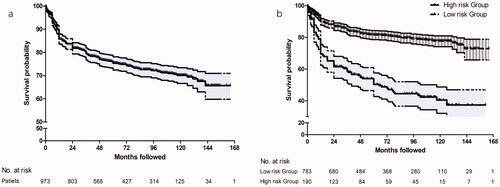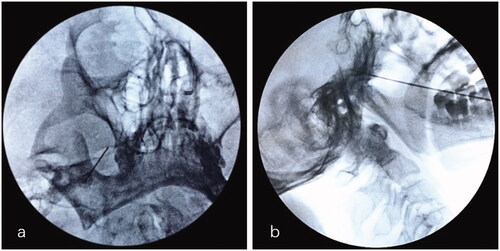Figures & data
Table 1. Cohort selection criteria for patients with maxillary TN receiving RFT.
Figure 1. Puncture of Gasserian ganglion for on V2 selective RFT through FO approach. (a) The puncture needle entering the right FO along a quarter of the inner side wall of FO on the coaxial image of FL. (b) The tip of the needle is placed in middle third between the clivus and skull base on the lateral image of FL. V2: maxillary nerve; FO: foramen ovale; FL: fluoroscopy.

Table 2. Demographic characteristics of patients with and without initial effective response.
Figure 2. (a) Kaplan–Meier survival curve for patients with maxillary division TN after RFT over a 14-year follow-up period. The median pain-free survival was 112.0 months (95% CI: 107.5, 116.5). Tick marks illustrated censored observations. (b) Kaplan–Meier survival curves for patients in high-risk group and low-risk group after RFT over a 14-year follow-up period. Patients with PI > 0.387 had a higher risk for pain recurrence with HR = 5.575 (95% CI: 3.991–7.788, p < .001). Tick marks illustrated censored observations. TN: trigeminal neuralgia; RFT: radiofrequency thermocoagulation; CI: confidence interval; PI: prognostic index.

Table 3. Recurrence risk factors of the patients from univariate regression.
Table 4. Recurrence risk factors of the patients from multivariable regression.
Table 5. Adverse event post-RFT of the patients.
Data availability statement
The data that support the findings of this study are available from the corresponding author, Professor Liangliang He, upon reasonable request.
